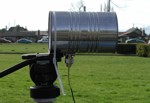
|
|
ENCYCLOPEDIA OF RADIO ELECTRONICS AND ELECTRICAL ENGINEERING How to build a 2,4 GHz antenna. Encyclopedia of radio electronics and electrical engineering
Encyclopedia of radio electronics and electrical engineering / Antennas. Theory More than one year has passed since the time when I found out that a home local network has "registered" across the street from me, which now unites almost 100 computers. Of course, connecting to it has become perhaps my most obsessive idea, however, given that the nearest house, which this network combines, is at least 100-150 meters, plus tram tracks and the roadway make up a considerable hindrance, to run a cable , even at a good stretch, is simply not possible. However, my friend, who lives in the Zeleny Lug microdistrict, told me that they had two local networks operating in their district for a long time, united using a wireless connection of the 802.11b standard. After "running" through the sellers of computer components, I found a pair of network cards of this standard of a very reputable D-Link trademark costing less than fifty dollars. each. A suitable window in the house opposite was also found, but the main issue arose behind the antennas. A good omnidirectional antenna of the same D-Link brand cost about 70 "green". I could not find decent branded directional antennas anywhere, and the matter, as they say, stalled. However, all the same my friend said that the users of just those same networks did not begin to spend money on expensive antennas to solve this problem, but simply made them. Cheap and quite high quality. Well, I, in turn, hasten to tell you about it. So, to make this "craft" you will need:
The choice of bank is entirely up to you. Even a cardboard can with metal foil inside from under Pringles chips will do. However, connoisseurs call tin cans with a diameter of about 10 cm (but not less than 7.5 cm) and a height of more than 13,5 cm optimal. It is desirable that the bottom of the jar be even, while the walls can be wavy, but not too much. Just NEVER cut off the top edge of the can, otherwise it will simply fall apart along the connecting seam. N-jack ("mother"), however, like a plug and cable, can be easily found on the radio market. The type of socket you choose, whether it be a socket secured with screws or a common nut, is entirely up to you. The main thing is that the connection is strong and least laborious for you. The diameter of the emitter wire should be approximately 2 mm, its length can be calculated on a special calculator located here on this site: saunalahti.fi/elepal/antenna2calc.php. It may be that you do not have access to the Internet. Then you can use the data from this table:
The emitter length in this case is 31 mm. The wire is carefully soldered to the central core of the connector. Be careful not to drip tin on the "ground", thereby shorting the contacts. Now, based on the diameter of our can, we calculate the appropriate distance from the waveguide (piece of wire) to the bottom of the can. For this distance, 1/4 wavelength of the conductor is well suited. This distance means the distance from the inner wall of the can, not from where the wall of the can ends. The more accurate the dimensions, the better the result and the stronger the signal. The antenna is ready, you can connect the cable and start testing. The strength of the signal largely depends on the direction, so you need to point the antenna quite accurately. To do this, you can, for example, use a laser pointer. If you decide to place the antenna outside the apartment, then to protect the emitter from moisture, it is advisable to use a plastic cover that transmits radio waves. You can check whether the lid you have chosen is suitable or not by placing it in the microwave along with a glass of water. If after a couple of minutes the water boils, and the lid does not even heat up, everything is fine. If the melted plastic evenly covers the glass tray, you will have to find something more suitable. :) With the length of the cable from the network board to the antenna, I would advise you to be greedy, because every extra meter pretty much weakens the signal.
Author: VanoID, VanoID@tut.by; Publication: radioradar.net
Artificial leather for touch emulation
15.04.2024 Petgugu Global cat litter
15.04.2024 The attractiveness of caring men
14.04.2024
▪ three dimensional transistor ▪ New Garmin fenix 5 multisport smart watch series
▪ section of the Radio Control website. Article selection ▪ article Issue to the mountain. Popular expression ▪ What do wasps build their nests out of? Detailed answer ▪ article Something about smuggling. Spy things ▪ article Prefix - capacitance meter. Encyclopedia of radio electronics and electrical engineering ▪ article Replacing one card with another. Focus Secret
Home page | Library | Articles | Website map | Site Reviews www.diagram.com.ua |






 Arabic
Arabic Bengali
Bengali Chinese
Chinese English
English French
French German
German Hebrew
Hebrew Hindi
Hindi Italian
Italian Japanese
Japanese Korean
Korean Malay
Malay Polish
Polish Portuguese
Portuguese Spanish
Spanish Turkish
Turkish Ukrainian
Ukrainian Vietnamese
Vietnamese


 Leave your comment on this article:
Leave your comment on this article: